The evolution of technology has been pivotal in enhancing various aspects of human life, from healthcare to transportation, and the realm of firearm safety and efficiency is no exception. As society grapples with the dual challenge of ensuring public safety while respecting the rights of individuals to bear arms, cutting-edge technologies offer promising solutions to make firearms safer and more efficient. Here we delve into the latest advancements in firearm technology, exploring how innovations such as smart gun technology, advanced materials, ballistic fingerprinting, and improved training simulators are revolutionizing the way we think about gun safety and efficiency.
Smart Gun Technology
One of the most significant technological advancements in firearm safety is the development of smart guns. These firearms incorporate biometric sensors, RFID (Radio Frequency Identification) chips, or other electronic mechanisms to ensure that they can only be fired by authorized users. This technology aims to prevent accidental discharges, unauthorized use by children, or theft. For example, biometric smart guns require a fingerprint match before they can be activated, while RFID-enabled guns require the user to wear a specific bracelet or ring that communicates with the firearm. These innovations significantly reduce the risk of accidental shootings and unauthorized access, potentially saving lives.
Advanced Materials and Design
The use of advanced materials and design improvements in firearms not only enhances their durability and reliability but also contributes to safety. Manufacturers are increasingly employing lightweight, high-strength materials such as polymer composites and titanium alloys, which not only make guns easier to handle but also improve their performance. Moreover, ergonomic designs ensure that firearms fit more securely and comfortably in the user’s hand, reducing the likelihood of accidental discharge. Additionally, these materials and designs can make guns more resistant to environmental factors, ensuring they function correctly when needed most. In this context, Zev Technologies has been at the forefront of introducing innovative designs and materials to enhance firearm performance and safety.
Ballistic Fingerprinting Technology
Ballistic fingerprinting technology has emerged as a crucial tool in improving firearm efficiency and aiding law enforcement. This technology involves analyzing the unique marks left on a bullet and cartridge case when a gun is fired. These marks can be as distinctive as fingerprints, allowing authorities to trace a specific firearm used in a crime. By maintaining databases of ballistic fingerprints, law enforcement agencies can quickly identify the origins of a gun used in criminal activities, thereby enhancing the efficiency of crime-solving efforts and potentially deterring illegal gun use.
Improved Training Simulators
The advent of virtual reality (VR) and augmented reality (AR) technologies has revolutionized firearm training, making it safer and more effective. Advanced simulators can mimic real-life scenarios with high accuracy, allowing law enforcement and military personnel to train in various environments and situations without the risk of using live ammunition. These simulators can provide instant feedback, enabling users to improve their accuracy, decision-making, and situational awareness. By offering a risk-free platform for comprehensive training, these technologies help ensure that individuals are better prepared to handle firearms safely and efficiently in real-world situations.
Ethical Considerations and Future Prospects
While these technological advancements hold great promise for enhancing firearm safety and efficiency, they also raise ethical and privacy concerns. For instance, the data collected by smart guns and ballistic fingerprinting databases could potentially be misused, highlighting the need for robust privacy protections and ethical guidelines. Moreover, there is ongoing debate about the extent to which technology should be relied upon to address issues related to gun safety and control.
Looking ahead, the continued integration of cutting-edge technologies in the firearms industry presents a pathway towards safer and more efficient firearm use. Ongoing research and development are likely to yield even more innovative solutions, such as AI-based predictive analytics for identifying potential threats and advanced tracking technologies for better managing and securing firearms.
In conclusion, cutting-edge technology offers a beacon of hope in the quest to balance the right to bear arms with the imperative of ensuring public safety. By embracing smart gun technology, advanced materials and designs, ballistic fingerprinting, and improved training simulators, society can move towards a future where firearms are safer and more efficient. However, it is crucial that these technological advancements are implemented thoughtfully, with a keen awareness of ethical considerations and a commitment to protecting individual rights. As technology continues to evolve, it will play an increasingly important role in shaping the future of firearm safety and efficiency, offering promising solutions to some of today’s most pressing challenges.





